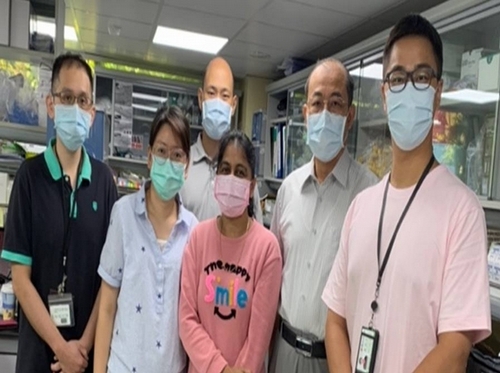實驗室成員

組長 鄭仁坤 醫師
研究人員
楊道翔 博士、Raju Poongodi 博士
陳弘照、朱翠玉
進駐研究醫師:黃健中 醫師、王資俊 醫師
Core Laboratory 5

組長 鄭仁坤 醫師
研究人員
楊道翔 博士、Raju Poongodi 博士
陳弘照、朱翠玉
進駐研究醫師:黃健中 醫師、王資俊 醫師
1. Establish animal pain (postoperative, inflammatory and neuropathic) models and explore the pathogenesis of different pain status.
2. Test the antinociceptive and neurotoxic effects of intrathecal analgesics.
3. We investigated the effects of exosomes derived from human umbilical cord mesenchymal stem cell (UCMSC) in animal models of nerve injury–induced pain and spinal cord injury.
陽明交大神研所:曹美玲 教授、連正章 教授
馬偕醫學院:彭賢佑 教授
馬偕醫院病理科
馬偕醫研部:楊崑德 教授
馬偕醫院麻醉部主治、住院醫師參與研究計劃及實驗技術研習
大鼠脊髓腔導管置入及持續給藥幫浦
大鼠術後疼痛、癌症疼痛、神經受損後慢性神經痛
發炎性疼痛模型、 spinal cord injury model
大鼠熱痛覺、觸痛覺行為檢測、gait analysis
西方墨點法、雙螢光免疫組織染色
In the past few years, we have explored the possible working mechanism and neurotoxic effect of intrathecal gabapentin, a calcium channel and NMDA-R modulator, in animal pain models. In addition, we found the antinociceptive effect of JNK inhibitor in the mice cancer pain model. We focused on the study of T-type calcium channels and cannabinoid receptors in the L5/6 spinal nerve ligation (SNL)-induced neuropathic pain. We presented several lines of evidence to show that CB1R and CB2R play important roles in modulating nerve injury-induced pain and neuroinflammation. Recently, We have explored the new therapy approach for neuropathic pain by developing a cell-free treatment that is able to retain the benefits of mesenchymal stem cell (MSC)-based therapy without the inherent difficulties of MSC. Umbilical cord MSC exosomes display excellent and long-lasting antinociceptive effects in the SNL pain model. Furthermore, the homing ability and potential regenerative properties of UCMSC exosomes make themselves a promising therapeutic candidate for nerve injury-induce pain. Recently, we also found the therapeutic effects of HucMSC exosome in the spinal cord injury model. Our works have been published in international high-impact factor scientific journals.
Poongodi R, Yang TH, Huang YH, Yang KD, Chen HZ, Chu TY, Wang TY, Lin HC, Cheng JK. Stem cell exosome-loaded Gelfoam improves locomotor dysfunction and neuropathic pain in a rat model of spinal cord injury. Stem Cell Research & Therapy 2024; 15(1):143. (SCIE, CELL & TISSUE ENGINEERING) (IF: 7.9, Ranking: 3/31=9.6%)
Lin YL, Yang ZS, Wong WY, Lin SC, Wang SJ, Chen SP, Cheng JK, Lu H, Lien CC. Cellular mechanisms underlying central sensitization in a mouse model of chronic muscle pain. eLife 2022; 11:e78610. (SCIE, BIOLOGY) (IF: 8.713, Ranking: 8/94=8.5%)
Poongodi R, Chen YL, Yang TH, Huang YH, Yang KD, Lin HC, Cheng JK. Bio-scaffolds as cell or exosome carriers for nerve injury repair. International Journal of Molecular Sciences 2021; 22(24):13347. (SCI, BIOCHEMISTRY & MOLECULAR BIOLOGY) (IF: 6.208, Ranking: 69/297=23.2%)
Hsu JM, Shiue SJ, Yang KD, Shiue HS, Hung YW, Pannuru P, Poongodi R, Lin HY, Cheng JK. Locally applied stem cell exosome-scaffold attenuates nerve injury-induced pain in rats. Journal of Pain Research 2020; 13:3257-3268. (SCIE, CLINICAL NEUROLOGY) (IF: 2.832, Ranking: 139/212=65.6%)
Shiue SJ, Rau RH, Shiue HS, Hung YW, Li ZX, Yang KD, Cheng JK. Mesenchymal stem cell exosomes as a cell-free therapy for nerve injury-induced pain in rats. Pain 2019; 160(1):210-223. (SCIE, CLINICAL NEUROLOGY) (IF: 7.926, Ranking: 21/212=9.9%)
Hsieh MC, Peng HY, Ho YC, Lai CY, Cheng JK, Chen GD, Lin TB. Transcription repressor Hes1 contributes to neuropathic pain development by modifying CDK9/RNAPII-dependent spinal mGluR5 transcription. International Journal of Molecular Sciences 2019; 20(17):4177. (SCIE, BIOCHEMISTRY & MOLECULAR BIOLOGY) (IF: 6.208, Ranking: 69/297=23.2%)